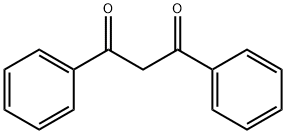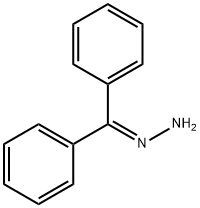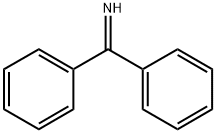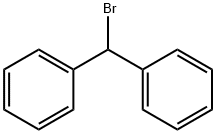Dibenzoylmethane
Synonym(s):1,3-Diphenyl-1,3-propanedione;Dibenzoylmethane
- CAS NO.:120-46-7
- Empirical Formula: C15H12O2
- Molecular Weight: 224.25
- MDL number: MFCD00003085
- EINECS: 204-398-9
- SAFETY DATA SHEET (SDS)
- Update Date: 2025-09-18 19:10:02

What is Dibenzoylmethane?
Chemical properties
Dibenzoylmethane (DB), a minor constituent of the root extract of licorice, belongs to the flavonoid family. It is a colorless rhombus flake crystal or yellowish-white powder. soluble in chlorohydrin and chloroform, soluble in sodium hydroxide solution, insoluble in sodium carbonate solution, and very slightly soluble in water. It is used as a colorimetric reagent for the determination of uranium.
Occurrence
Dibenzoylmethane(DBM) is a 1,3-diketone derivative of acetylacetone that has both methyl groups replaced with phenyl groups.Although smaller in size and lacking hydroxyl and methoxy groups,DBM resembles the turmeric spice curcumin (CUR),a diferuloylmethane. Both molecules are metal-chelating agents,contain a B-diketone flanked by two aryl groups,and exhibit anti-proliferative and anticarcinogenic activity. In addition to sharing structural similarity with DBM,CUR,which is also a naturally occurring compound is found in the plant Curcuma longa and has numerous medicinal uses.
DBM and its many naturally occurring derivatives are minor constituentsof licorice. DBM has been isolated from licorice root extracts and otherspecies of Glycyrrhiza.
The Uses of Dibenzoylmethane
Dibenzoylmethane is a new kind of PVC heat stabilizer, it has better transparency, nontoxic and odorless. In case of combined use with Calcium/Zinc, Barium/Zin and other heat stabilizer, it can greatly improve the initial color, transparency, long term stability of PVC, and also can improve the precipitation and “zinc burning” problem during the process. It has very good synergy with zinc soaps, and can protect the PVC color. This material can absorb UV at 290nm, which has the effect as light stabilizer and act as long term stabilizer for PVC products.
The Uses of Dibenzoylmethane
Dibenzoylmethane is a compound known to inhibit tumorigenesis in mice.
What are the applications of Application
Dibenzoylmethane is a compound known to inhibit tumorigenesis in mice
Definition
ChEBI: Dibenzoylmethane is a beta-diketone that is acetylacetone (acac) in which both methyl groups have been replaced by phenyl groups. It is a minor constituent of the root extract of licorice (Glycyrrhiza glabra) and exhibits antimutagenic and anticancer effects. It has a role as an antineoplastic agent, a metabolite and an antimutagen. It is a beta-diketone and an aromatic ketone.
Preparation
dibenzoylmethane is prepared by condensation of ethyl benzoate with acetophenone.
Synthesis Reference(s)
Tetrahedron Letters, 37, p. 3885, 1996 DOI: 10.1016/0040-4039(96)00689-2
Chemical and Pharmaceutical Bulletin, 29, p. 2762, 1981 DOI: 10.1248/cpb.29.2762
Flammability and Explosibility
Non flammable
Safety Profile
Moderately toxic by ingestion. When heated to decomposition it emits acrid smoke and irritating vapors
Purification Methods
Dibenzoylmethane (1,3-diphenyl-1,3-propanedione) [120-46-7] M 224.3, m 8 0o. Crystallise dibenzoylmethane from pet ether or MeOH. [Beilstein 7 IV 2512.]
Properties of Dibenzoylmethane
| Melting point: | 77-79 °C(lit.) |
| Boiling point: | 219-221 °C18 mm Hg(lit.) |
| Density | 0.800 g/cm3 |
| vapor pressure | 0.01Pa at 20℃ |
| refractive index | 1.6600 (estimate) |
| Flash point: | 219-221°C/18mm |
| storage temp. | Store below +30°C. |
| solubility | Chloroform (Slightly), Methanol (Slightly, Sonicated) |
| pka | 8.95±0.10(Predicted) |
| form | Crystals |
| color | Light yellow to yellow |
| Water Solubility | It is Soluble in ether, chloroform, and aqueous sodium hydroxide. Insoluble in water. |
| Merck | 14,3009 |
| BRN | 514910 |
| Stability: | Stable. Incompatible with strong oxidizing agents. |
| CAS DataBase Reference | 120-46-7(CAS DataBase Reference) |
| NIST Chemistry Reference | 1,3-Propanedione, 1,3-diphenyl-(120-46-7) |
| EPA Substance Registry System | 1,3-Propanedione, 1,3-diphenyl- (120-46-7) |
Safety information for Dibenzoylmethane
| Signal word | Warning |
| Pictogram(s) |
 Exclamation Mark Irritant GHS07 |
| GHS Hazard Statements |
H315:Skin corrosion/irritation H319:Serious eye damage/eye irritation H335:Specific target organ toxicity, single exposure;Respiratory tract irritation |
| Precautionary Statement Codes |
P261:Avoid breathing dust/fume/gas/mist/vapours/spray. P271:Use only outdoors or in a well-ventilated area. P280:Wear protective gloves/protective clothing/eye protection/face protection. |
Computed Descriptors for Dibenzoylmethane
| InChIKey | NZZIMKJIVMHWJC-UHFFFAOYSA-N |
Dibenzoylmethane manufacturer
New Products
Indole Methyl Resin tert-butyl 9-methoxy-3-azaspiro[5.5]undecane-3-carboxylate Boc-His(Boc)-OH 2-CTC Resin 4-Chloro-7-tosy1-7Hpyrrolo[2,3-d]pyrimidine 5,7-Dibromo-1H-indole 2,5-dichloro-N-hydroxy-4,6-dimethylpyridine-3-carboximidamide 2,2-Dimethoxy-7-azaspiro[3.5]nonane hydrochloride 4-chloromethyl-5-methyl-1,3-dioxol-2-one (DMDO-Cl) R-2-BENZYLOXY PROPIONIC ACID 1,1’-CARBONYLDIIMIDAZOLE 1,1’-CARBONYLDI (1,2-4 TRIAZOLE) N-METHYL INDAZOLE-3-CARBOXYLIC ACID 4-((2-hydroxyethyl)thio)benzoic acid 1-(TERT-BUTOXYCARBONYL)-2-PYRROLIDINONE Methyl 6-methylnicotinate 3-Pyridineacrylic acid tert-Butyl carbazate TETRAHYDRO-2H-PYRAN-3-OL 2-((4-morpholinophenylamino) (methylthio) methylene) malononitrile 3-(4-morpholinophenylamino)-5-amino-1H-pyrazole-4-carbonitrile 2,4-dihydroxybenzaldehyde 1,3-Diethyl-1,3-Diphenylurea Methyl 2-methylquinoline-6-carboxylateRelated products of tetrahydrofuran








You may like
-
 120-46-7 1,3-DI PHENYL-1,3-PROPANEDIONE 98%View Details
120-46-7 1,3-DI PHENYL-1,3-PROPANEDIONE 98%View Details
120-46-7 -
 Dibenzoylmethane CAS 120-46-7View Details
Dibenzoylmethane CAS 120-46-7View Details
120-46-7 -
 1,3-Diphenyl-1,3-propanedione CAS 120-46-7View Details
1,3-Diphenyl-1,3-propanedione CAS 120-46-7View Details
120-46-7 -
 1,3-Diphenyl-1,3-propanedione CAS 120-46-7View Details
1,3-Diphenyl-1,3-propanedione CAS 120-46-7View Details
120-46-7 -
 DibenzoylmethaneView Details
DibenzoylmethaneView Details
120-46-7 -
 Dibenzoyl MethaneView Details
Dibenzoyl MethaneView Details
120-46-7 -
 Pyridine 99.5% HPLC /UV SpectroscopyView Details
Pyridine 99.5% HPLC /UV SpectroscopyView Details
110-86-1 -
 Thiourea 99% ARView Details
Thiourea 99% ARView Details
62-56-6
